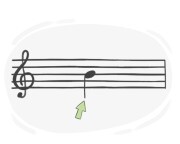

全音符
ピアニストは左手で全音符を弾きながら、右手でメロディーを飾りました。

調
作曲家は交響曲のためにト長調の調を選び、その明るく高揚する特性を強調しました。

中央のド
メロディーは中央Cから始まり、曲の安定した出発点を提供します。

ナチュラル
音楽家は、以前にシャープされた後、F音を元のピッチに戻すためにナチュラルを追加しました。

オクターブ
ピアニストは完全なオクターブにわたる音階を演奏した。

和音
ギタリストは曲を始めるためにGメジャーコードを弾きました。

シャープ
作曲家はF音の前にシャープを付けて、半音高く演奏すべきことを示しました。

二分音符
そのメロディーは一連の二分音符を特徴としており、曲全体に流れるようなリズムを作り出しています。

四分音符
メロディーは一連の四分音符で始まり、曲のリズムパターンを確立します。

主音
その曲は主音で終わり、終結感と閉鎖感を与えた。

小節線
作曲家は各小節の終わりをマークするために小節線を引きました。

音部記号
楽譜は五線の始まりに高音部記号が付けられており、より高音の楽器や声のために意図されていたことを示していました。

タブラチュア
彼は伝統的な楽譜ではなくタブラチュアを読んで曲を演奏することを学びました。

八分音符
そのメロディーは、音楽に勢いを生み出す八分音符の速い連続を特徴としていました。

十六分音符
メロディーは16分音符で始まり、速いリズムパターンを導入しました。

三十二分音符
その曲の速いテンポの部分は、演奏者の妙技を披露する三十二分音符の連続を特徴としていました。

六十四分音符
その速いパッセージには六十四分音符の連なりが特徴で、正確で機敏な指の動きを必要としました。

共通拍子
指揮者はオーケストラに4分の4拍子で演奏を開始するよう合図し、1小節に4拍の安定したリズムを設定しました。

スラー
ピアニストはスラーを使ってレガートの一節の音符をつなぎ、シームレスで流れるようなメロディーを作り出しました。

四分音
作曲家はメロディーに四分音を取り入れ、ユニークでエキゾチックな音を作り出しました。

臨時記号
鋭い臨時記号が音符のピッチを半音上げた。

アルペジオ
クラシックギターの曲で、ミュージシャンは美しいアルペジオで彼のスキルを披露し、和音の個々の音を強調しました。

トリル
フルート奏者は完璧なトリルを実行し、音楽の一節に装飾を加えました。

音符の価値
作曲家は各音符に注意深く音符の価値を割り当て、作曲におけるその持続時間とリズム的な重要性を決定しました。












































